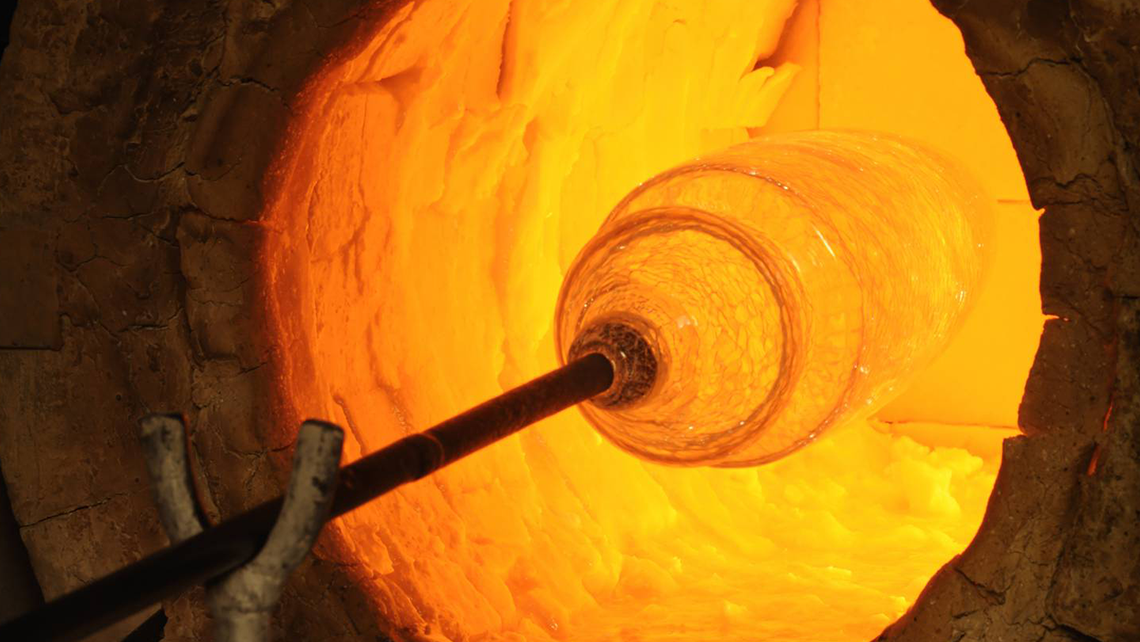
Researchers at Pennsylvania State University in the US have recently discovered a new type of glass that could cut the carbon footprint of glass production by up to half. With the glass industry currently producing around 86 million tonnes of greenhouse gases equivalent to carbon dioxide worldwide, it is hoped that this innovation could truly revolutionise glass production.
The glass-making process
Glass is an amorphous inorganic material, which simply means that there is no regular repetition in its structure. According to some records, glass was already being produced in ancient Egypt around 5000 years ago. It is usually made from silica (or sand), which is heated, melted and then cooled, where it solidifies without forming a crystal structure, taking its final shape. This is known as silicate glass, to which many other additives are added during manufacture, each of which can affect the properties of the glass.
One might legitimately ask: how much does the production of glass pollute the environment? The most common type of glass used in everyday life is the so-called soda-lime silicate glass, which is also used to make simple windows and drinks bottles. As its name suggests, it is made up of three main components: soda ash (sodium carbonate), limestone (also known as calcium carbonate) and quartz. Of these, both sodium carbonate and calcium carbonate decompose into carbon dioxide when heated. And without proper care during production, they can easily be released into the atmosphere, causing major pollution of the environment. It is not the gases produced but the furnaces that do the heating that are responsible for the most damage: melting the glass requires high temperatures (up to 1500-1600 °C), which require a lot of energy and indirectly contribute to the production of carbon dioxide.
One might legitimately ask: how much does the production of glass pollute the environment? The most common type of glass used in everyday life is the so-called soda-lime silicate glass, which is also used to make simple windows and drinks bottles. As its name suggests, it is made up of three main components: soda ash (sodium carbonate), limestone (also known as calcium carbonate) and quartz. Of these, both sodium carbonate and calcium carbonate decompose into carbon dioxide when heated. And without proper care during production, they can easily be released into the atmosphere, causing major pollution of the environment. It is not the gases produced but the furnaces that do the heating that are responsible for the most damage: melting the glass requires high temperatures (up to 1500-1600 °C), which require a lot of energy and indirectly contribute to the production of carbon dioxide.
How can development help?
The new type of glass, developed by researchers at Pennsylvania State University, is called LionGlass after the university's mascot, and they hope it could cut emissions by up to half. The patenting process is currently underway. It is planned that the Innovation Day will enable a major reduction in the need to heat energy-intensive furnaces to high temperatures. This special glass can be melted at temperatures as low as 3-400°C to make it malleable. This solution would also reduce energy consumption by almost 30% compared to conventional silicate glass production.
Other benefits of innovation include. Among them, LionGlass is also proving to be incredibly strong: researchers were surprised at how much more resistant it was to cracking than ordinary glass. For some compositions, it proved so strong that a force ten times greater than the crack resistance of soda-lime glass failed to crack the prototype. The researchers added that this still did not reach the limits of LionGlass, but only the maximum strength of the device used to make it. This means that this new type of glass could even be capable of much higher load-bearing capacities.
The developers hope that the reinforced structure of LionGlass will also allow the weight of devices and components made from it to be reduced. This could play a particularly important role in car windows, for example. Each lightening of a vehicle can reduce its fuel consumption and thus its emissions. Everything is in place to do this, as glass that is ten times stronger than conventional developments could be much thinner in most cases. In addition, by reducing the amount of material needed to manufacture a window pane, the amount of waste that can be generated can be reduced, resulting in a significant overall reduction in environmental impact and emissions.
Other benefits of innovation include. Among them, LionGlass is also proving to be incredibly strong: researchers were surprised at how much more resistant it was to cracking than ordinary glass. For some compositions, it proved so strong that a force ten times greater than the crack resistance of soda-lime glass failed to crack the prototype. The researchers added that this still did not reach the limits of LionGlass, but only the maximum strength of the device used to make it. This means that this new type of glass could even be capable of much higher load-bearing capacities.
The developers hope that the reinforced structure of LionGlass will also allow the weight of devices and components made from it to be reduced. This could play a particularly important role in car windows, for example. Each lightening of a vehicle can reduce its fuel consumption and thus its emissions. Everything is in place to do this, as glass that is ten times stronger than conventional developments could be much thinner in most cases. In addition, by reducing the amount of material needed to manufacture a window pane, the amount of waste that can be generated can be reduced, resulting in a significant overall reduction in environmental impact and emissions.






